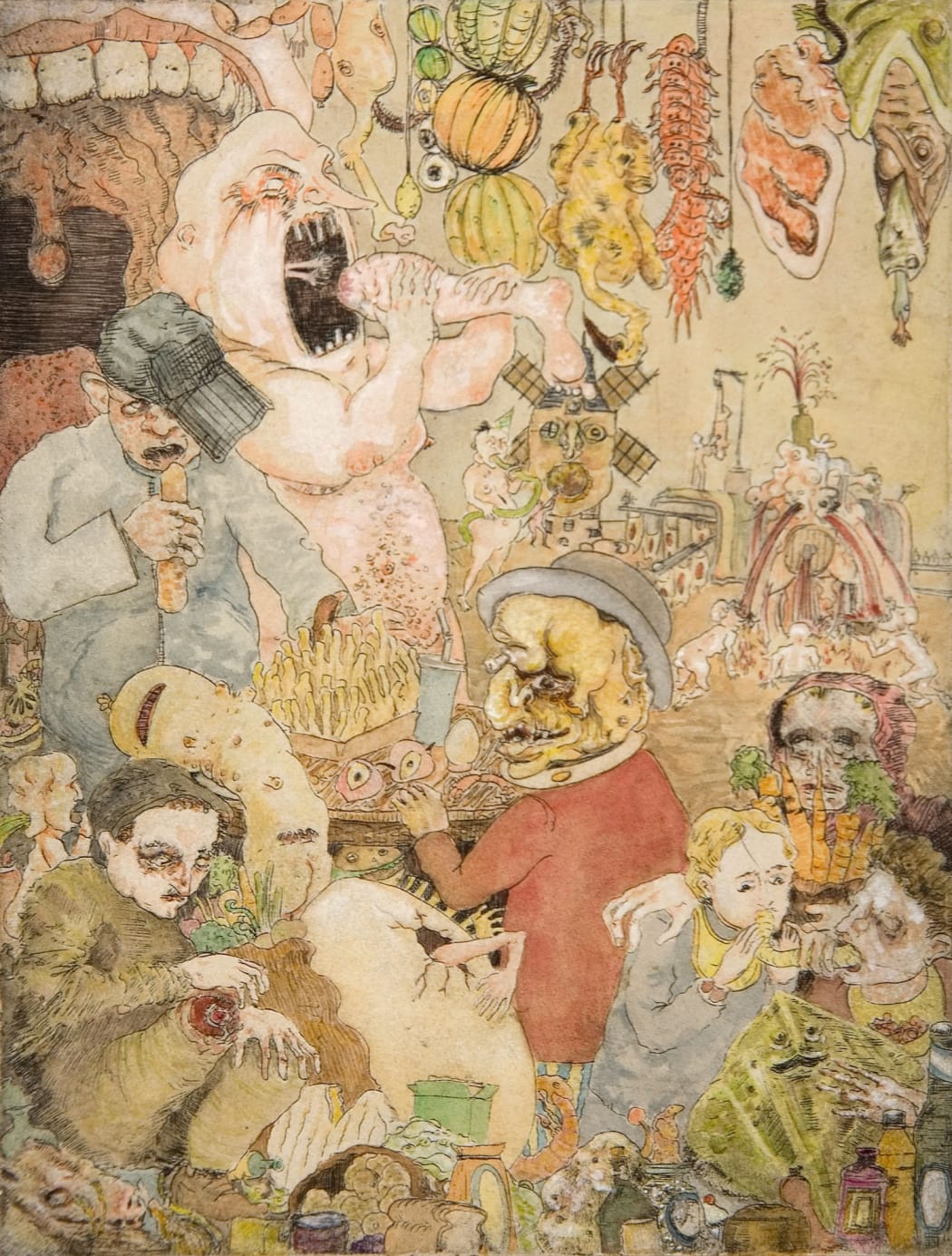
The Triumph of Silence
This picture is set during Orpheus’ last concert. He’s been pretty bummed (understandably) since the underworld incident, and he blames himself (quite rightly) that Eurydice is still down there. All the songs he has sung after he got back from Hades have been unbearably sad - this is the person who sang the sirens to suicide.
At the centre of the picture is a stage surrounded by an enormous stadium. There is a huge cosmic organ (like Robert Fludd’s) putting down some beats and the light show cuts up through the aquatint dark to illuminate the heavenly spheres dancing to their own celestial rhythm. Down below, the crowd is going crazy. Maenads have surged onto the stage (Bacchic super-fans) and are tearing Orpheus limb from limb because he wouldn’t have sex with them all. His head, still singing, is tossed into a nearby river where it floats, still singing, forever more.
Palette: grimy black, dingy orange and vivid purple. Orpheus is drawn a bit like a mid-70s Robert Plant.
The Great Wall
The Ancient Chinese and the Romans shared an interest in geomancy. Both were also enthusiastic wall builders. The Romans had a god of borders and partitions, known as Terminus, who was honoured at liminal spaces and at the fringes of the empire, but was also recognised at the very heart of Rome itself. In fact, their civilisation was said to have started with the building of a wall – this picture shows that wall.
As soon as the wall is built, Remus becomes foreign to Romulus. When Remus steps over the ramparts to tease his brother, without qualm and without hesitation, Romulus kills him. It is the principle of the thing.
Palette: Raw sienna, rodent grey.
Cartophagy
An anthromorphic political map like those that were popular at the start of WW1 where each country is represented as a person in national dress. This version depicts a fictional pair of continents made up of a dozen or so states. Each of these states possesses a gaping mouth and a set of perfectly formed teeth, and each one is engaged in devouring its neighbour.
Palette: Peach, cream, Prussian blue and British Empire pink.
Architecture of Solitude
Apollodorus of Damascus was the architect to the Emperor Hadrian. This picture is in the architect’s studio. There are models of buildings everywhere, large skyscrapers with sheer walls and steep angles that accentuate their height. It is a celebration of the vertical. Grounded by these miniature towers are ramps, walkways and aqueducts. Apollodorus is a proponent of International Classicism.
Like Hitler, Hadrian was a despot who fancied himself as an architect. In the picture he would be shown entering the studio holding architectural models of his own design. They are all mock-Tudor cottages with thatched roofs and little squiggly chimney pots. The emperor is seeking the architect’s opinion on his work. He will urge the architect to “Go on, be honest”, and so the architect will tell the emperor exactly what he thinks of the architecture of nostalgia.
Henceforth Apollodorus will be exiled to a remote forsaken place to build shacks for the local ruffians to vandalise, waiting for the orders that will eventually arrive that will condemn the architect to be buried alive in the foundations of one of the emperor’s new buildings.
Palette: tangerine and dove grey
Only Connect
A portrait of the entire population of the world. As of June 2018, that population is counted at 7.6 billion, so I would probably need to have group sittings. The scale would be slightly larger than life to give a bit of grandeur. Each person would be looking at the other 7.6 billion minus one in the eye and -this is clear from the shape of the lips – they would be whispering “I love you”.
Already dead people will not be included, since it probably needs to be kept simple.
Palette – varied but mostly beige.
